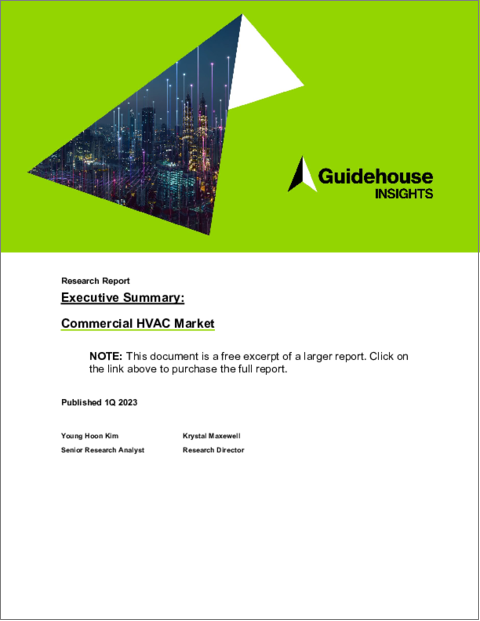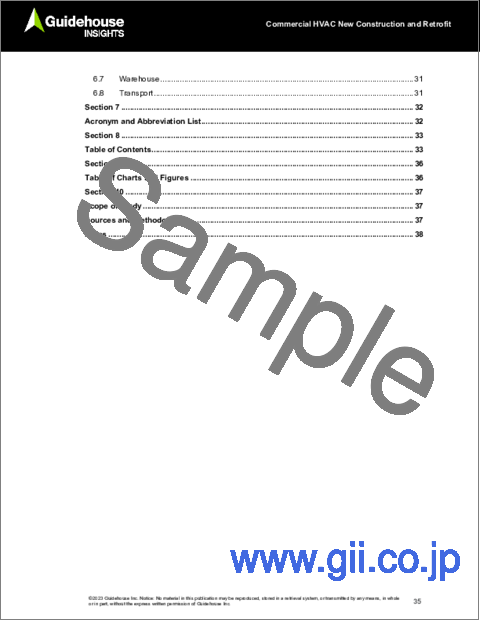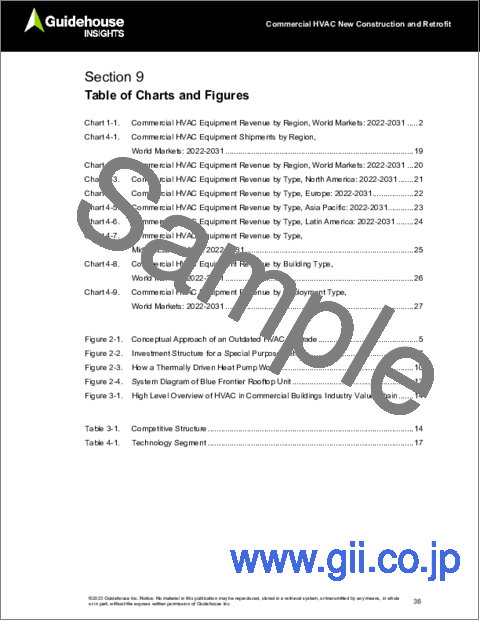|
|
市場調査レポート
商品コード
1249908
業務用HVACの世界市場Commercial HVAC Market: Global Commercial Heating and Cooling Equipment Market Analysis and Forecasts, 2022-2031 |
||||||
| 業務用HVACの世界市場 |
|
出版日: 2023年03月29日
発行: Guidehouse Insights
ページ情報: 英文 39 Pages; 45 Tables, Charts & Figures
納期: 即納可能
|
- 全表示
- 概要
- 図表
- 目次
世界の業務用HVACの市場規模は、2022年に517億米ドルとなりました。同市場は今後、2.8%のCAGRで拡大し、2031年には666億米ドルに拡大すると予測されています。
当レポートでは、世界の業務用HVAC市場について調査し、市場の概要とともに、促進要因と抑制要因、業界のバリューチェーン、今後の市場予測などを提供しています。
目次
第1章 エグゼクティブサマリー
第2章 市場の問題
- ビル改修の市場機会
- 老朽化した商業ビルのHVAC改修
- 促進要因
- 抑制要因
- 持続可能な冷暖房の市場動向
第3章 業界のバリューチェーン
- 商業ビルHVAC業界
- 競合情勢
第4章 市場予測
- 予測調査手法
- 予測範囲
- 市場概要
- 地域予測
- 北米
- 欧州
- アジア太平洋
- ラテンアメリカ
- 中東・アフリカ
- 建物・工法別予測
第5章 結論・提言
- 推奨事項
- 政府関係者および政策立案者
- ユーティリティ
- 建物所有者
- エンジニアリング会社
- メーカー
第6章 市場予測
- オフィス
- 小売
- 教育
- ヘルスケア
- ホテルとレストラン
- 公的機関/会議場
- 倉庫
- 輸送
第7章 頭字語と略語のリスト
第8章 目次
第9章 図表
第10章 調査範囲
第11章 情報源、調査手法、および注記
List of Tables
- Commercial HVAC Equipment Shipments by Region, World Markets: 2022-2031
- Commercial HVAC Equipment Shipments by Type, North America: 2022-2031
- Commercial HVAC Equipment Shipments by Type, Europe: 2022-2031
- Commercial HVAC Equipment Shipments by Type, Asia Pacific: 2022-2031
- Commercial HVAC Equipment Shipments by Type, Latin America: 2022-2031
- Commercial HVAC Equipment Shipments by Type, Middle East & Africa: 2022-2031
- Commercial HVAC Equipment Revenue by Region, World Markets: 2022-2031
- Commercial HVAC Equipment Revenue by Type, North America: 2022-2031
- Commercial HVAC Equipment Revenue by Type, Europe: 2022-2031
- Commercial HVAC Equipment Revenue by Type, Asia Pacific: 2022-2031
- Commercial HVAC Equipment Revenue by Type, Latin America: 2022-2031
- Commercial HVAC Equipment Revenue by Type, Middle East & Africa: 2022-2031
- Commercial HVAC Equipment Revenue by Building Type, World Markets: 2022-2031
- Commercial HVAC Equipment Revenue by Building Type, North America: 2022-2031
- Commercial HVAC Equipment Revenue by Building Type, Europe: 2022-2031
- Commercial HVAC Equipment Revenue by Building Type, Asia Pacific: 2022-2031
- Commercial HVAC Equipment Revenue by Building Type, Latin America: 2022-2031
- Commercial HVAC Equipment Revenue by Building Type, Middle East & Africa: 2022-2031
- Commercial HVAC Equipment Revenue by Deployment Type, World Markets: 2022-2031
- Commercial HVAC Equipment Revenue by Deployment Type, North America: 2022-2031
- Commercial HVAC Equipment Revenue by Deployment Type, Europe: 2022-2031
- Commercial HVAC Equipment Revenue by Deployment Type, Asia Pacific: 2022-2031
- Commercial HVAC Equipment Revenue by Deployment Type, Latin America: 2022-2031
- Commercial HVAC Equipment Revenue by Deployment Type, Middle East & Africa: 2022-2031
Competitive Structure
Technology Segment
List of Figures
- Commercial HVAC Equipment Revenue by Region, World Markets: 2022-2031
- Commercial HVAC Equipment Shipments by Region, World Markets: 2022-2031
- Commercial HVAC Equipment Revenue by Type, North America: 2022-2031
- Commercial HVAC Equipment Revenue by Type, Europe: 2022-2031
- Commercial HVAC Equipment Revenue by Type, Asia Pacific: 2022-2031
- Commercial HVAC Equipment Revenue by Type, Latin America: 2022-2031
- Commercial HVAC Equipment Revenue by Type, Middle East & Africa: 2022-2031
- Commercial HVAC Equipment Revenue by Building Type, World Markets: 2022-2031
- Commercial HVAC Equipment Revenue by Deployment Type, World Markets: 2022-2031
- Commercial HVAC Equipment Revenue by Region, World Markets: 2022-2031
- Commercial HVAC Equipment Shipments by Region, World Markets: 2022-2031
- Commercial HVAC Equipment Revenue by Type, Middle East & Africa: 2022-2031
- Commercial HVAC Equipment Revenue by Building Type, World Markets: 2022-2031
- Commercial HVAC Equipment Revenue by Deployment Type, World Markets: 2022-2031
Conceptual Approach of an Outdated HVAC Upgrade
Investment Structure for a Special Purpose Vehicle
How a Thermally Driven Heat Pump Works
System Diagram of Blue Frontier Rooftop Unit
High Level Overview of HVAC in Commercial Buildings Industry Value Chain
The commercial heating, ventilation, and air-conditioning (HVAC) market has grown continuously as heating and cooling technologies advance. Looking forward, market stakeholders, including manufacturers, engineers, and service providers, have several growth opportunities. Among them are the increasing demand for heating and cooling in emerging regions and the number of aging commercial buildings with obsolete HVAC equipment. The IEA reports that by 2030, nearly 20% of the existing building stock will require renovation to reach zero-carbon emissions. Since no one solution will accommodate all regions worldwide-for either residential or commercial HVAC-industry stakeholders must consider regional-specific solutions. Additionally, they must consider multiple sustainable heating and cooling solutions that will accommodate global decarbonization efforts and adapt them to each region and to the building types within those regions.
This report reviews the different commercial HVAC solutions for heating and cooling and provides forecasts for the ten-year period between 2023 and 2032, segmented by technology and five geographic regions: North America, Europe, Asia Pacific, Latin America, and Middle East & Africa.
Global market revenue for commercial HVAC is anticipated to grow from $51.7 billion in 2022 to $66.6 billion in 2031 at a CAGR of 2.8%. Asia Pacific is expected to be the largest market throughout the forecast period, growing at a CAGR of 3.0%. North America is anticipated to be second (2.9% CAGR), and Europe is expected to be third (2.8% CAGR). Latin America and Middle East & Africa will likely show smaller, but steady growth.
Table of Contents
1. Executive Summary
- 1.1 Introduction
- 1.2 Market Forecast
2. Market Issues
- 2.1 Market Opportunities for Building Renovation
- 2.1.1 Retrofitting HVAC in Aging Commercial Buildings
- 2.2 Drivers
- 2.2.1 Policy and Incentives Supporting Efficient System Installation and Upgrades
- 2.2.2 Technology Advances
- 2.2.2.1 Advanced Control
- 2.2.3 Financing and as a Service Opportunities
- 2.3 Barriers
- 2.3.1 Increased Equipment Prices Due to High Demand for Efficient Systems
- 2.3.2 Reluctance to Improve Systems Because of Doubts about the Benefits
- 2.3.3 Disrupted Supply Chain
- 2.3.4 Shortage of Experts
- 2.4 Market Trend for Sustainable Heating and Cooling
- 2.4.1 Clean Gas
- 2.4.2 Electrification
- 2.4.3 Thermally Driven Heating
- 2.4.4 Dual Fuel (Hybrid)
- 2.4.5 Liquid Desiccant Cooling
- 2.4.6 Efficient Fossil Fuel-based Heating
3. Industry Value Chain
- 3.1 Commercial Building HVAC Industry
- 3.2 Competitive Landscape
- 3.2.1 Industry Activities
- 3.2.1.1 Partnership
- 3.2.1.2 Business Expansion
- 3.2.1.3 Energy Efficiency Projects
- 3.2.1 Industry Activities
4. Market Forecasts
- 4.1 Forecast Methodology
- 4.2 Forecast Scope
- 4.2.1 Differences from Previous Forecasts
- 4.3 Market Overview
- 4.4 Regional Forecasts
- 4.4.1 North America
- 4.4.2 Europe
- 4.4.3 Asia Pacific
- 4.4.4 Latin America
- 4.4.5 Middle East & Africa
- 4.5 Forecasts by Building and Construction Types
- 4.5.1 Building Type
- 4.5.2 Construction Type
5. Conclusions and Recommendations
- 5.1 Recommendations
- 5.1.1 Government Officials and Policymakers
- 5.1.2 Utilities
- 5.1.3 Building Owners
- 5.1.4 Engineering Companies
- 5.1.5 Manufacturers
6. Market Forecasts
- 6.1 Office
- 6.2 Retail
- 6.3 Education
- 6.4 Healthcare
- 6.5 Hotels and Restaurants
- 6.6 Institutional/Assembly
- 6.7 Warehouse
- 6.8 Transport




